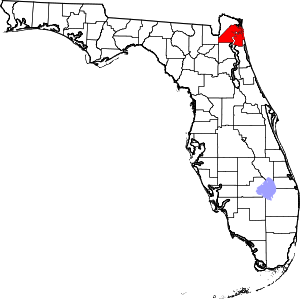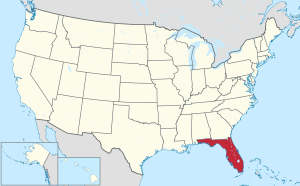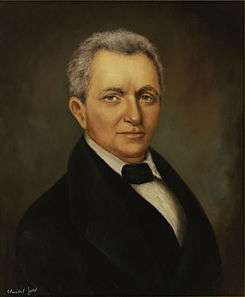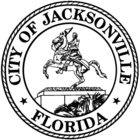Duval County, Florida
Duval County is located in the northeastern part of the U.S. state of Florida. As of the 2010 census, the population was 864,263, with a 2019 estimate at 957,755, the seventh most populous in Florida.[2][3] Its county seat is Jacksonville, with which the Duval County government has been consolidated since 1968.[4] Duval County was established in 1822, and is named for William Pope Duval, Governor of Florida Territory from 1822 to 1834.
Duval County | |
|---|---|
Duval County Courthouse | |
 Location within the U.S. state of Florida | |
 Florida's location within the U.S. | |
| Coordinates: 30°20′N 81°39′W | |
| Country | |
| State | |
| Founded | August 12, 1822[1] |
| Named for | William Pope Duval |
| Seat | Jacksonville |
| Largest city | Jacksonville |
| Area | |
| • Total | 918 sq mi (2,380 km2) |
| • Land | 762 sq mi (1,970 km2) |
| • Water | 156 sq mi (400 km2) 17.0%% |
| Population | |
| • Estimate (2019) | 957,755[2] |
| • Density | 1,231/sq mi (475/km2) |
| Time zone | UTC−5 (Eastern) |
| • Summer (DST) | UTC−4 (EDT) |
| Congressional districts | 4th, 5th |
| Website | coj |
Duval County is included in the Jacksonville, FL Metropolitan Statistical Area.
History
This area had been settled by varying cultures of indigenous peoples for thousands of years before European contact. Within the Timucuan Ecological and Historic Preserve in Jacksonville, archeologists have excavated remains of some of the oldest pottery in the United States, dating to 2500 BCE. Prior to European contact, the area was inhabited by the Mocama, a Timucuan-speaking group who lived throughout the coastal areas of northern Florida.[5] At the time Europeans arrived, much of what is now Duval County was controlled by the Saturiwa, one of the region's most powerful tribes. The area that became Duval County was home to the 16th-century French colony of Fort Caroline, and saw increased European settlement in the 18th century with the establishment of Cowford, later renamed Jacksonville.
Duval County was created in 1822 from St. Johns County. It was named for William Pope Duval, Governor of Florida Territory from 1822 to 1834.[6] When Duval County was created, it covered a massive area, from the Suwannee River on the west to the Atlantic Ocean on the east, north of a line from the mouth of the Suwannee River to Jacksonville on the St. Johns River. Alachua and Nassau counties were created out of parts of Duval County in 1824. Clay County was created from part of Duval County in 1858. Part of St. Johns County south and east of the lower reaches of the St. Johns River was transferred to Duval County in the 1840s.[7]
 Portrait of William Pope Duval
Portrait of William Pope Duval Duval County Courthouse in 1894
Duval County Courthouse in 1894- Jacksonville in 1909

.jpeg) Jacksonville Beach in 2018.
Jacksonville Beach in 2018.
Government
On October 1, 1968, the government of Duval County was consolidated with the government of the city of Jacksonville. The Duval County cities of Atlantic Beach, Jacksonville Beach, and Neptune Beach, and the town of Baldwin are not included in the corporate limits of Jacksonville, and maintain their own municipal governments. The city of Jacksonville provides all services that a county government would normally provide.
Geography
According to the U.S. Census Bureau, the county has an area of 918 square miles (2,380 km2), of which 762 square miles (1,970 km2) is land and 156 square miles (400 km2) (17.0%) is water.[8] The topography is coastal plain; however there are some rolling hills.
National protected areas
- Fort Caroline National Memorial
- Timucuan Ecological and Historic Preserve
Adjacent counties
- Nassau County - north/west
- St. Johns County - southeast
- Clay County - southwest
- Baker County - west
Demographics
| Historical population | |||
|---|---|---|---|
| Census | Pop. | %± | |
| 1830 | 1,970 | — | |
| 1840 | 4,156 | 111.0% | |
| 1850 | 4,539 | 9.2% | |
| 1860 | 5,074 | 11.8% | |
| 1870 | 11,921 | 134.9% | |
| 1880 | 19,431 | 63.0% | |
| 1890 | 26,800 | 37.9% | |
| 1900 | 39,733 | 48.3% | |
| 1910 | 75,163 | 89.2% | |
| 1920 | 113,540 | 51.1% | |
| 1930 | 155,503 | 37.0% | |
| 1940 | 210,143 | 35.1% | |
| 1950 | 304,029 | 44.7% | |
| 1960 | 455,411 | 49.8% | |
| 1970 | 528,865 | 16.1% | |
| 1980 | 571,003 | 8.0% | |
| 1990 | 672,971 | 17.9% | |
| 2000 | 778,879 | 15.7% | |
| 2010 | 864,263 | 11.0% | |
| Est. 2019 | 957,755 | [9] | 10.8% |
| U.S. Decennial Census[10] 1790-1960[11] 1900-1990[12] 1990-2000[13] 2010-2019[3] | |||
2010 Census
U.S. Census Bureau 2010 Ethnic/Race Demographics:[14][15]
- White (non-Hispanic) (60.9% when including White Hispanics): 56.6% (10.7% German, 10.6% Irish, 9.2% English, 4.1% Italian, 2.3% French, 2.1% Scottish, 2.1% Scotch-Irish, 1.8% Polish, 1.2% Dutch, 0.6% Russian, 0.6% Swedish, 0.6% Norwegian, 0.5% Welsh, 0.5% French Canadian)[14]
- Black (non-Hispanic) (29.5% when including Black Hispanics): 28.9% (1.7% Subsaharan African, 1.4% West Indian/Afro-Caribbean American [0.5% Haitian, 0.4% Jamaican, 0.1% Other or Unspecified West Indian, 0.1% Bahamian])[14][16]
- Hispanic or Latino of any race: 7.6% (2.5% Puerto Rican, 1.7% Mexican, 0.8% Cuban)[14][17]
- Asian: 4.2% (1.7% Filipino, 0.8% Indian, 0.6% Other Asian, 0.4% Vietnamese, 0.3% Chinese, 0.2% Korean, 0.1% Japanese)[14][15]
- Two or more races: 2.9%
- American Indian and Alaska Native: 0.4%
- Native Hawaiian and Other Pacific Islander: 0.1%[14][15]
- Other Races: 2.1% (0.9% Arab)[14]
In 2010, 6.7% of the population considered themselves to be of only "American" ancestry (regardless of race or ethnicity.)[14]
Of the 342,450 households 28.68% had children under the age of 18 living with them, 41.92% were married couples living together, 16.74% had a female householder with no husband present, and 36.27% were non-families. 24.85% of households were one person and 8.05% (2.29% male and 5.76% female) had someone living alone who was 65 or older. The average household size was 2.47 and the average family size was 3.04.[15][18]
The age distribution was 23.5% under the age of 18, 10.5% from 18 to 24, 28.4% from 25 to 44, 26.4% from 45 to 64, and 11.1% 65 or older. The median age was 35.8 years. For every 100 females there were 94.3 males. For every 100 females age 18 and over, there were 91.6 males.[18]
The median household income was $49,463 and the median family income was $60,114. Males had a median income of $42,752 versus $34,512 for females. The per capita income for the county was $25,854. About 10.4% of families and 14.2% of the population were below the poverty line, including 20.3% of those under age 18 and 9.6% of those aged 65 or over.[19]
In 2010, 9.0% of the county's population was foreign born, with 49.5% being naturalized American citizens. Of foreign-born residents, 38.2% were born in Latin America, 35.6% born in Asia, 17.9% were born in Europe, 5.8% born in Africa, 2.0% in North America, and 0.5% were born in Oceania.[14]
2000 Census
The racial makeup of the county was 65.80% White (63.6% were Non-Hispanic White,)[20] 27.83% African American or Black, 0.33% Native American, 2.71% Asian, 0.06% Pacific Islander, 1.31% from other races, and 1.96% from two or more races. 4.10% of the population were Hispanic or Latino of any race.
Of the 303,747 households 33.30% had children under the age of 18 living with them, 46.50% were married couples living together, 15.60% had a female householder with no husband present, and 33.60% were non-families. 26.50% of households were one person and 7.80% were one person aged 65 or older. The average household size was 2.51 and the average family size was 3.06.
The age distribution was 26.30% under the age of 18, 9.60% from 18 to 24, 32.40% from 25 to 44, 21.20% from 45 to 64, and 10.50% 65 or older. The median age was 34 years. For every 100 females there were 94.20 males. For every 100 females age 18 and over, there were 90.90 males.
The median household income was $40,703 and the median family income was $47,689. Males had a median income of $32,954 versus $26,015 for females. The per capita income for the county was $20,753. 11.90% of the population and 9.20% of families were below the poverty line, including 16.40% of those under the age of 18 and 11.60% of those age 65 or older.
Languages
As of 2010, 87.36% of all residents spoke English as their first language, while 5.74% spoke Spanish, 1.18% Tagalog, 0.53% Arabic, 0.48% Serbo-Croatian, 0.47% Vietnamese, and 0.46% of the population spoke French Creole (mostly Haitian Creole,) as their mother language.[21] In total, 12.64% of the population spoke languages other than English as their primary language.[21]
Politics
Voter registration
According to the Secretary of State's office, Democrats comprise a plurality of registered voters in Duval County.
| Duval County Voter Registration & Party Enrollment as of September 30, 2015[22] | |||||
|---|---|---|---|---|---|
| Political Party | Total Voters | Percentage | |||
| Democratic | 220,483 | 40.98% | |||
| Republican | 197,916 | 36.79% | |||
| Independent | 102,533 | 19.06% | |||
| Third Parties | 17,058 | 3.17% | |||
| Total | 537,990 | 100.00% | |||
Statewide and national elections
Duval County is somewhat conservative for an urban county. It began moving away from the Democratic Party somewhat sooner than the rest of Florida. Despite the small Democratic plurality in registration, the county's Democrats are nowhere near as liberal as their counterparts in other large Florida counties, such as Miami-Dade and Orange. The county has only supported a Democrat for president four times since 1956, the last being in the 1976 cycle when Jimmy Carter managed to take the county.
The Republican edge in Duval has lessened somewhat in recent years. It swing from a 16-point win for George W. Bush in 2004 to only a three-point win for John McCain in 2008. Mitt Romney won an equally narrow margin in 2012. In 2016, Donald Trump only won the county by fewer than 6,000 votes even as he narrowly carried Florida.
| Year | Republican | Democratic | Third parties |
|---|---|---|---|
| 2016 | 48.48% 211,672 | 47.12% 205,704 | 4.40% 19,197 |
| 2012 | 51.27% 211,615 | 47.67% 196,737 | 1.06% 4,381 |
| 2008 | 50.53% 210,537 | 48.63% 202,618 | 0.85% 3,538 |
| 2004 | 57.78% 220,190 | 41.62% 158,610 | 0.59% 2,261 |
| 2000 | 57.49% 152,460 | 40.74% 108,039 | 1.76% 4,682 |
| 1996 | 49.96% 126,959 | 44.20% 112,328 | 5.84% 14,836 |
| 1992 | 49.47% 123,631 | 36.85% 92,098 | 13.68% 34,197 |
| 1988 | 62.79% 128,081 | 36.72% 74,894 | 0.49% 1,004 |
| 1984 | 62.41% 128,724 | 37.57% 77,488 | 0.02% 37 |
| 1980 | 50.45% 98,664 | 46.26% 90,466 | 3.28% 6,424 |
| 1976 | 41.08% 74,997 | 58.01% 105,912 | 0.90% 1,652 |
| 1972 | 72.19% 122,154 | 27.50% 46,530 | 0.31% 520 |
| 1968 | 30.89% 51,585 | 32.84% 54,834 | 36.27% 60,559 |
| 1964 | 50.55% 81,116 | 49.45% 79,365 | |
| 1960 | 45.73% 59,073 | 54.27% 70,091 | |
| 1956 | 50.17% 53,481 | 49.83% 53,127 | |
| 1952 | 48.27% 50,346 | 51.73% 53,949 | |
| 1948 | 25.76% 15,379 | 47.85% 28,567 | 26.38% 15,749 |
| 1944 | 24.89% 12,220 | 75.11% 36,867 | |
| 1940 | 18.29% 9,177 | 81.71% 41,003 | |
| 1936 | 17.12% 5,368 | 82.88% 25,989 | |
| 1932 | 24.25% 6,096 | 75.75% 19,038 | |
| 1928 | 63.39% 16,919 | 34.91% 9,316 | 1.70% 454 |
| 1924 | 28.93% 3,291 | 51.93% 5,908 | 19.14% 2,177 |
| 1920 | 31.18% 6,628 | 64.21% 13,650 | 4.61% 979 |
| 1916 | 16.83% 1,339 | 68.57% 5,456 | 14.60% 1,162 |
| 1912 | 5.20% 243 | 75.26% 3,514 | 19.54% 912 |
| 1908 | 18.00% 641 | 66.84% 2,381 | 15.16% 540 |
| 1904 | 21.91% 671 | 65.65% 2,011 | 12.44% 381 |
| Year | Democratic | Republican | Third parties |
|---|---|---|---|
| 2018 | 51.7% 196,537 | 47.4% 179,869 | .9% 3,431 |
| 2014 | 41.49% 112,026 | 54.22% 146,407 | 4.29% 11,600 |
| 2010 | 45.88% 120,097 | 51.60% 135,074 | 2.52% 6,614 |
| 2006 | 38.93% 87,718 | 58.86% 132,607 | 2.21% 4,972 |
| 2002 | 38.01% 92,263 | 61.35% 148,923 | 0.64% 1,556 |
| 1998 | 39.85% 74,016 | 60.15% 111,716 | 0.00% 4 |
| 1994 | 42.53% 80,945 | 57.22% 108,900 | 0.25% 471 |
Education
Duval County Public Schools operates public schools in the county.
Duval County is served by the Jacksonville Public Library.
Communities
- 842,583 - Jacksonville
- 21,823 - Jacksonville Beach
- 12,985 - Atlantic Beach
- 7,124 - Neptune Beach
- 1,430 - Baldwin
2013 estimate population[24]
Transportation
Major highways
Airports
See also
References
- Publications of the Florida Historical Society. Florida Historical Society. 1908. p. 31.
- "State & County QuickFacts". United States Census Bureau. Retrieved June 22, 2019.
- "Population of Counties in Florida (2019)". World Population Review.
- "Find a County". National Association of Counties. Archived from the original on 2012-07-12. Retrieved 2011-06-07.
- Matt Soergel, "Archaeologists help distinguish Mocama group", Morris News Service, 25 October 2009, accessed 11 May 2010
- Gannett, Henry (1905). The Origin of Certain Place Names in the United States. Govt. Print. Off. pp. 111.
- Fernald, Edward A., Ed. (1981) Atlas of Florida. The Florida State University Foundation, Inc. ISBN 0-9606708-0-7 P.131
Alachua County Maps
Nassau County Maps
Clay County Maps - "US Gazetteer files: 2010, 2000, and 1990". United States Census Bureau. 2011-02-12. Retrieved 2011-04-23.
- "Population and Housing Unit Estimates". Retrieved March 26, 2020.
- "U.S. Decennial Census". United States Census Bureau. Retrieved June 13, 2014.
- "Historical Census Browser". University of Virginia Library. Retrieved June 13, 2014.
- "Population of Counties by Decennial Census: 1900 to 1990". United States Census Bureau. Retrieved June 13, 2014.
- "Census 2000 PHC-T-4. Ranking Tables for Counties: 1990 and 2000" (PDF). United States Census Bureau. Retrieved June 13, 2014.
- "Duval County: SELECTED SOCIAL CHARACTERISTICS IN THE UNITED STATES 2006-2010 American Community Survey 5-Year Estimates". United States Census Bureau. Retrieved October 22, 2015.
- "Duval County Demographic Characteristics". ocala.com. Archived from the original on April 3, 2016. Retrieved October 22, 2015.
- "Duval County, Florida FIRST ANCESTRY REPORTED Universe: Total population - 2006-2010 American Community Survey 5-Year Estimates". United States Census Bureau. Retrieved November 12, 2015.
- "Duval County, Florida Hispanic or Latino by Type: 2010 -- 2010 Census Summary File 1". United States Census Bureau. Retrieved October 22, 2015.
- "Duval County: Age Groups and Sex: 2010 - 2010 Census Summary File 1". United States Census Bureau. Retrieved October 22, 2015.
- "Duval County, Florida: SELECTED ECONOMIC CHARACTERISTICS - 2006-2010 American Community Survey 5-Year Estimates". United States Census Bureau. Retrieved November 18, 2015.
- "Demographics of Duval County, FL". MuniNetGuide.com. Archived from the original on April 13, 2009. Retrieved October 22, 2015.
- "Modern Language Association Data Center Results of Duval County, Florida". Modern Language Association. Retrieved October 22, 2015.
- "Archived copy". Archived from the original on 2016-10-24. Retrieved 2016-10-27.CS1 maint: archived copy as title (link)
- Leip, David. "Dave Leip's Atlas of U.S. Presidential Elections". uselectionatlas.org. Retrieved 2018-06-14.
- "Annual Estimates of the Resident Population for Incorporated Places in Florida". United States Census Bureau. Archived from the original on May 22, 2014. Retrieved April 22, 2014.
External links
| Wikimedia Commons has media related to Duval County, Florida. |
Government links
- City of Jacksonville official website of City of Jacksonville/Duval County


